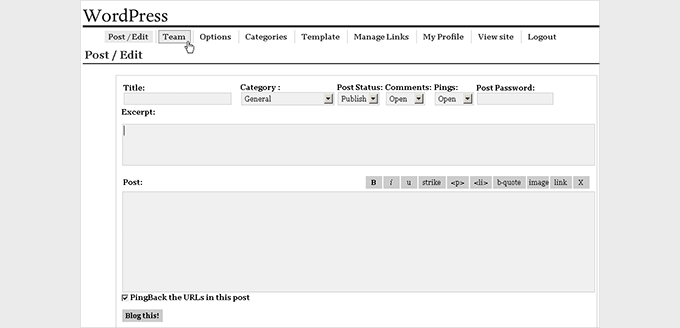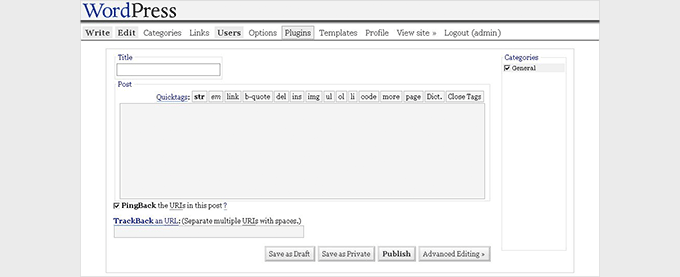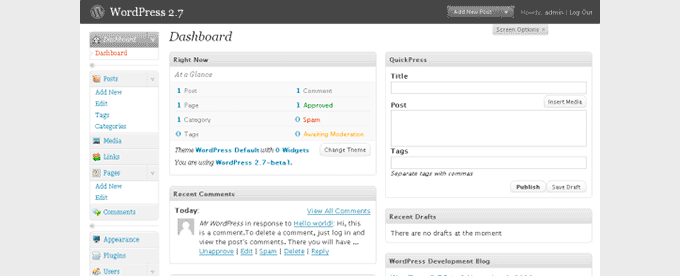20 Years’ Journey of WordPress – If you want to know the journey of WordPress from a blogging tool to becoming the world’s most famous content management system. Today we’re going to tell you about the History and Journey of WordPress from 2003 to 2024.
WordPress is the most famous free and open-source platform that makes website creation easy and faster. It offers multiple features and functionality that give you complete freedom to design your website as you want.
On 27 May 2003, the two-man named American blogger Matt Mullenweg and British blogger Mike Little introduced a new open-source platform called “WordPress” to the world, and started the Journey of WordPress.
WordPress has continuously grown and evolved in nearly two decades since its inception, becoming the world’s most used content management system (CMS).
More than 43% of websites on the web have been built with WordPress till now, and this percentage will increase in upcoming years.
WordPress Overview
| Establish Year | 2003 |
| Founder | Matt Mullenweg and Mike Little |
| First Release | 27 May 2003, Version 0.7 |
| Latest Version | 29 March 2023, Version 6.2 |
20 Years Journey of WordPress
Over the last 20 years, WordPress introduced multiple features, bug fixes, and improvements through various versions. Let’s take a look at the history of WordPress.

The History of WordPress
Here is the quick list of WordPress versions from 2003-2024
| Version | Version Name | Date |
|---|---|---|
| 6.2 | Eric Dolphy | March 29, 2023 |
| 6.1 | Mikhail Alperin | November 1, 2022 |
| 6.0 | Arturo O’Farrill | May 24, 2022 |
| 5.9 | Joséphine Baker | January 25, 2022 |
| 5.8 | Art Tatum | July 20, 2021 |
| 5.7 | Esperanza Spalding | March 9, 2021 |
| 5.6 | Nina Simone | December 8, 2020 |
| 5.5 | Billy Eckstine | August 11, 2020 |
| 5.4 | Nat Adderley | March 31, 2020 |
| 5.3 | Rahsaan Roland Kirk | November 12, 2019 |
| 5.2 | Jaco Pastorius | May 7, 2019 |
| 5.1 | Betty Carter | February 21, 2019 |
| 5.0 | Bebo Valdés | December 6, 2018 |
| 4.9 | Billy Tipton | November 15, 2017 |
| 4.8 | Bill Evans | June 8, 2017 |
| 4.7 | Sarah Vaughan | December 6, 2016 |
| 4.6 | Pepper Adams | August 16, 2016 |
| 4.5 | Coleman Hawkins | April 12, 2016 |
| 4.4 | Clifford Brown | December 8, 2015 |
| 4.3 | Billie Holiday | August 18, 2015 |
| 4.2 | Bud Powell | April 23, 2015 |
| 4.1 | Dinah Washington | December 18, 2014 |
| 4.0 | Benny Goodman | September 4, 2014 |
| 3.9 | Jimmy Smith | April 16, 2014 |
| 3.8 | Charlie Parker | December 12, 2013 |
| 3.7 | Count Basie | October 24, 2013 |
| 3.6 | Oscar Peterson | August 1, 2013 |
| 3.5 | Elvin Jones | December 11, 2012 |
| 3.4 | Grant Green | June 13, 2012 |
| 3.3 | Sonny Stitt | December 12, 2011 |
| 3.2 | George Gershwin | July 4, 2011 |
| 3.1 | Django Reinhardt | February 23, 2011 |
| 3.0 | Thelonious Monk | June 17, 2010 |
| 2.9 | Carmen McRae | December 18, 2009 |
| 2.8 | Chet Baker | June 11, 2009 |
| 2.7 | John Coltrane | December 10, 2008 |
| 2.6 | McCoy Tyner | July 15, 2008 |
| 2.5 | Michael Brecker | March 29, 2008 |
| 2.3 | Dexter Gordon | September 24, 2007 |
| 2.2 | Stan Getz | May 16, 2007 |
| 2.1 | Ella Fitzgerald | January 22, 2007 |
| 2.0 | Duke Ellington | December 31, 2005 |
| 1.5 | Billy Strayhorn | February 17, 2005 |
| 1.2 | Charles Mingus | May 22, 2004 |
| 1.0 | Miles Davis | January 3, 2004 |
| .70 | No musician chosen. | May 27, 2003 |
WordPress was born on May 27, 2003, when Matt Mullenweg and Mike Little introduced the first version, 0.7, of this open-source platform. Inspired by the discontinuation of the b2/cafelog blogging software, Mullenweg and Little set out to create a new and improved platform for bloggers.
In 2003, two users of b2/cafelog, Matt Mullenweg and Mike Little, decided to create a new platform using the existing b2/cafelog as a foundation.
2003: Launched First Version

In May 2003, they released the first version, 0.7, of WordPress, a name suggested by blogger Christine Selleck. It was the improved version of b2 that introduced features like XHTML 1.1-compliant templates, a new admin interface, themes, and the ability to do some manual changes.
2004: Introduced with ‘Mingus’

In January 2004, WordPress released its next version, 1.0, named “Davis” after the renowned American trumpeter Miles Davis.
In May 2004, version 1.2, named “Mingus”, was released after the famous American Jazz musician Charles Mingus, which introduces support for plugins. These plugins are additional programs developed independently that enhance the functionality of WordPress websites.
Eventually, it opened up the possibility for developers and users to customize their WordPress sites according to their needs. It was one of the impactful updates in the journey of WordPress.
2005: Major Update

In February 2005, version 1.5 (Strayhorn) was released by WordPress. This update came with a new addition called themes, which were pre-built layouts for WordPress sites. Also, this update broke the header, footer, and sidebar into individual files so that if users make changes in one place, it will automatically update everywhere on your site.
In December 2005, version 2.0 (Duke) was released with a new admin dashboard. This update brought significant improvements to the user interface of the website, like the backend of WordPress became faster and more efficient, improved the editing experience, publishing new posts or articles became quicker, and many features, making it easy for users to create and manage their website.
In August 2005, one of the co-founders of WordPress, Matt Mullenweg founded a new company named “Automattic Inc” and on 1 March 2006, Automattic Inc officially registered the trademark of WordPress and its corporate logo.
2007: Introduce Auto Update

In January 2007, WordPress released its new version, 2.1, which includes an auto-saving feature. Now you won’t lose your editing anymore.
2008: Various Updates
In 2008 WordPress added new features throughout the year, like shortcodes, plugin installation, and easy updates, through various releases.
2010: Another Major Update
In June 2010, WordPress released a new version, 3.0 (Thelonious), which turn it out for a significant milestone in the journey of WordPress.
This new release includes many new features, like custom post type, improved custom taxonomies, headers, menus, customizable backgrounds, and more. It was also introduced with a new default theme, Twenty Ten.
Moreover, the WordPress MU project merged with the WordPress core to form the Multisite networks. So from then, it was easy for users to create multiple sites on a single WordPress installation.
2011: Post Format and Admin Bar
Version 3.1 was released this year, which gives multiple features, including redesigned workspace with improved functionality, like post format support, network admin, import and export enhancements, and other improvements that offer more flexibility and customization options.
Also, in that time, some new plugins were developed that allow you to design an e-commerce website.
2012 to 2017: Bug Fixes, Security, and Maintenance
In between these years, WordPress immensely worked to improve its core functionality and ensure a better user experience.
WordPress, released in 2012, introduced a theme customizer, previewer, and media manager. So users can easily edit the colours, background, and images as they want, make their gallery, and see the preview of these changes.
In 2013 and 2014, WordPress changed its dashboard appearance and made it easier to use for any device. It also improves support for more languages, visual post editor, live widget preview, and other options.
Another big event happened in the journey of WordPress in 2015 when Automattic Inc acquired WooCommerce, the best WordPress plugin for creating eCommerce websites.
Various versions released in 2016 and 2017 focused on refinement and ease of use. The updation of plugins and themes, different languages in the admin panel, and added custom CSS features with a live preview make customization easy.
The release of version 4.9 in 2017 added features like widgets that allow you to add video, audio, image, text, and more, which improved the overall customization ability of the website.
2018: Introduced With Gutenberg
In 2018, the journey of WordPress turned into a new era when they released version 5.0, which introduced a new WordPress block editor called Gutenberg.
The main motto of this release was to replace the famous Classic editor with a new block-based editor to improve the site editing experience, speed, and performance. To know more about Gutenberg, read our article on how to set up a website using the WordPress block editor.
2019 to 2021: Site Health, Lazy Loading Image, and Drag-and-Drop Inserter
In between these years, various version was launched from 5.1 to 5.8. In 2019, versions 5.1 and 5.2 focused on improving site health. It provides users to fix their fatal errors through recovery mode.
Even in the year (2020) of the pandemic, the journey of WordPress didn’t stop its growth and released three versions, 5.4, 5.5, and 5.6. In addition to several changes, some essential improvements were made, such as improving the block editor’s functionality and making customization easier. It also includes new features like block patterns, block directories, and privacy settings, and introduced the lazy loading of images for better site performance.
In 2021 versions 5.7 and 5.8 were released that focused on the block editor. The update provides more control over the block pattern and style, a one-click switch between HTTP to HTTPS, and makes it easy to drag and drop the blocks for creating a website.
2022: Full Site Editing

In 2022, version 5.9 was released, focused on continuing to improve the functionality of the Gutenberg Block Editor. More block patterns and features were added that enhance the full-site editing experience.
On 24 May 2022, version 6.0 was launched to bring more full-site editing features, including multiple style variations, new templates, more design tools, block locking control, and improved performance.
WordPress 6.1 (Misha) version was released on 1 November 2022, which includes a new default full-site editing theme Twenty Twenty-Three, supports fluid typography, lock setting for all blocks, navigation editing option, content-only editing, and more.
2023: Reimagined Site Editor
Version, 6.2 (Dolphy) was released on 29 March 2023, which was another major update in the journey of WordPress, which enhances the site editor, better menu management, new header, and footer pattern, improves the writing experience, and more. It also improves performance and functionality.
If you wish to know more about WordPress you can visit their history page here.
Conclusion
From the simple blogging tool to the world’s most used content management system, WordPress has grown significantly since its first release on May 27, 2003.
The journey of WordPress over the years has gone through significant changes and added many new features through various updates. With each new version, they introduced new features, and bug fixes, to enhance the performance and make it more accessible for users.
What next, WordPress will continue its growth and commitment to improving its core functionality and providing a more user-friendly and feature-rich platform for every user.
FAQ
Q: When was the first version of WordPress released?
Ans: The first version of WordPress, version 0.7, was released on 27 May 2003.
Q: Who founded WordPress?
Ans: In 2003, American blogger Matt Mullenweg and British blogger Mike Little started WordPress as a fork of b2.
Q: What is the latest major version of WordPress?
Ans: The latest version of WordPress is 6.2 (Dolphy), released on 29 March 2023.
Q: Major updates of WordPress?
Ans: The first major update was released in 2004, version 1.2, and in upcoming years more major updates through major versions, like 1.5, 2.0, 3.0, 5.0, 5.9, and 6.2.
We hope this article helped you to know the 20 years’ journey of WordPress.
If you find this article helpful, do share it with your friends. And If you have any questions regarding this, do not hesitate to comment below. We will help you to solve your problem. Thanks for reading this blog.
Please Subscribe to our YouTube Channel, we also upload great content there, and also Do Follow us on Facebook and Twitter.
Read More-
- 19 Best Free WordPress Block Themes [Full Site Editing]
- 20 Best Free WordPress Agency Themes [Top Picks]
- 14+ Best Free WooCommerce WordPress Themes for eCommerce Websites
- 51+ Best Free WordPress Plugins For Your Website
Recommended WordPress Themes
| Theme | Purpose | Get Deal |
|---|---|---|
| Zita | Multipurpose | Get Discount |
| Oneline | One Page | Get Discount |
| Divi | Multipurpose | Get Discount |
| GeneratePress | Multipurpose | Get Discount |
